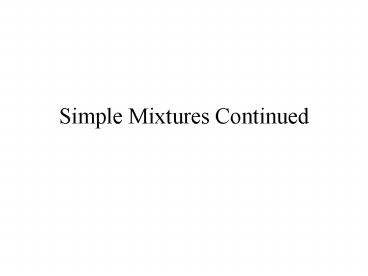Simple Mixtures Continued - PowerPoint PPT Presentation
1 / 16
Title:
Simple Mixtures Continued
Description:
Since there is no interaction between molecules in a perfect gas, DHMIX=0. ... 946. 756. 363. 205. P/Torr. 0.0024. 0.0019. 0.009. 0.005. x. Problem 7.15b(a) ... – PowerPoint PPT presentation
Number of Views:46
Avg rating:3.0/5.0
Title: Simple Mixtures Continued
1
Simple Mixtures Continued
2
Gibbs Energy of Mixing of Perfect Gases
- Recall, mmolar Gibbs Energy
3
Entropy and Enthalpy of Mixing
- Mole fractions are always lt0. Therefore, DSMIX
is always gt0. - Since there is no interaction between molecules
in a perfect gas, DHMIX0.
4
Note the form of the Curves
5
Problem 7.13b
6
Chemical Potentials of Ideal Solutions
- When A(l) is in equilibrium with A(g) at a
partial pressure PA, then - Recall, mA for a vapor is
- Therefore, at equilibrium
7
Chemical Potentials of Ideal Solutions
- Raoults Law
- Measured the partial vapor pressure of each
component in a mixture - Discovered that the partial pressure of the
solvent of a solution was lower than the pressure
of the pure solvent
8
Chemical Potentials of Ideal Solutions
- Using Raoults Law, substitute for PA
Constants for a given substance at a given
temperature
9
Problem 7.9b
10
Ideal Binary Solutions
- Raoults Law applies to each component (A and B)
- The total pressure of the system follows Daltons
Law
11
Ideal-Dilute Solutions
- A solute lowers the chemical potential of a
solvent - increases the disorder of the solvent
- The disorder of a solvent of a solution is higher
but it has a lower tendency to achieve disorder
than the pure solvent. - this reduction in potential is m lower than m.
12
Ideal-Dilute Solutions
- Raoults Law describes properties of an almost
pure solvent in a real solution. - Raoults Law does not work well in describing the
partial vapor pressure of the solute. - Since it its the minor component, the solute is
far from its pure state - However, it is known that the partial vapor
pressure of the solute is proportional to the
mole fraction of the solute. - The slope of this line is different that what
Raoults Law describes
13
Henrys Law
- The vapor pressure of a volatile solute (b), is
equal to its mole fraction in solution times a
constant characteristic of the solute - KB is the pressure at xB1 determined by a line
that is tangential to the point at xB0
14
Limitations
Limitations
- Raoults and Henrys Laws are valid only at low
concentrations of solute and solvent,
respectively.
15
Problem
- Estimate Henrys Law constant for methylene
chloride given the following data
16
Problem 7.15b(a)































